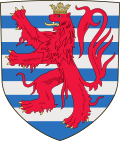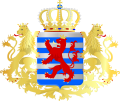Mariana of Austria
 From Wikipedia - Reading time: 16 min
From Wikipedia - Reading time: 16 min
| Mariana of Austria | |
|---|---|
 Portrait of Mariana of Austria by Diego Velázquez, 1652–53 | |
| Queen consort of Spain | |
| Tenure | 7 October 1649 – 17 September 1665 |
| Queen regent of Spain | |
| Regency | 17 September 1665 – 6 November 1675 |
| Monarch | Charles II |
| Born | 24 December 1634 Wiener Neustadt, Archduchy of Austria, Holy Roman Empire |
| Died | 16 May 1696 (aged 61) Palace of the Councils, Madrid, Crown of Castile |
| Burial | |
| Spouse | |
| Issue Among others | |
| House | Habsburg |
| Father | Ferdinand III, Holy Roman Emperor |
| Mother | Maria Anna of Spain |
| Signature |  |
Mariana of Austria[a] (24 December 1634 – 16 May 1696) was Queen of Spain from 1649 until the death of her husband Philip IV of Spain in 1665. Appointed regent for their infant son Charles II, she remained an influential figure until her death in 1696.
Her regency was overshadowed by the Decline of Spain in the second half of the 17th century, and internal political divisions, combined with a general European economic crisis. Charles' failure to produce an heir ultimately ended in the 1701 to 1714 War of the Spanish Succession.
Birth and early years
[edit]Mariana was born on 24 December 1634 in Wiener Neustadt, second child of Maria Anna of Spain and her husband Ferdinand (1608–1657), who became Holy Roman Emperor in 1637. Her parents had three children who survived into adulthood, Mariana, and her two brothers, Ferdinand (1633–1654) and Leopold (1640–1705), elected emperor in 1658.[1]
In 1646, Mariana was betrothed to her cousin Balthasar Charles, Prince of Asturias, heir to the Spanish throne. His death soon afterwards left her without a prospective husband and her widowed uncle Philip IV without a successor. The solution was a marriage between Philip and his niece on 7 October 1649 at Navalcarnero, outside Madrid.[2]

Only two of their five children survived to adulthood. The eldest, Margaret Theresa, married her maternal uncle Leopold I, Holy Roman Emperor in 1666. Mariana's second daughter, Maria Ambrosia, lived only fifteen days, followed by two sons, Philip Prospero and Ferdinand Thomas. On 6 November 1661, Mariana gave birth to her last child, a son, Charles.[3] Subject to ill health for much of his life, one study argues this may have been caused by genetic disorders inherited from his parents.[4]
Regency
[edit]
First regency: 1665–1677
[edit]Charles was three years old when Philip died on 17 September 1665, and Mariana was appointed regent, advised by a Regency Council, until he became a legal adult at the age of 14. She adopted the valido[b] system established by Philip in 1620, the first being Juan Everardo Nithard, an Austrian Jesuit and her personal confessor; as Philip's will excluded foreigners from the Regency Council, he had to be naturalised, causing immediate resentment.[5] Other informal advisors included Gaspar de Bracamonte, 3rd Count of Peñaranda and Mariana Engracia Álvarez de Toledo Portugal y Alfonso-Pimentel.[6]
Charles' poor health and lack of an heir meant his reign was often dominated by a power struggle between Mariana's Austrian faction, and a pro-French lobby initially led by his illegitimate half-brother, John of Austria the Younger. Spain was also divided into the Crowns of Castile and Aragon, whose very different political cultures made it almost impossible to enact reforms or increase taxes. As a result, government finances were in perpetual crisis, the Crown declaring bankruptcy in 1647, 1652, 1661, and 1666.[7]

Spain was exhausted by almost a century of continuous war, while the second half of the 17th century coincided with a period of extreme cold weather known as the Little Ice Age. Between 1692 and 1699, crops failed across Europe and an estimated 5–10% of the population starved to death.[8] The new government inherited other problems, the long-running Portuguese Restoration War being the most urgent. This was made worse in May 1667 when France once again invaded the Spanish Netherlands, and occupied the Spanish province of Franche-Comté.[9] The Treaty of Aix-la-Chapelle (1668) ended the war with France, while the Treaty of Lisbon (1668) restored Portugal's independence.[10]
Peace ended the drain on Spanish resources, while France returned most of the territories over-run in the War of Devolution. They represented a significant diplomatic achievement, but many Spanish military officers considered the terms humiliating. Joseph Malladas, an Aragonese captain, was executed in June 1668 for plotting to murder Nithard, reputedly on John's behalf.[11] In February 1669, Nithard was succeeded as valido by Aytona, who died in 1670 and was replaced in turn by Valenzuela, a member of her household since 1661.[12] An outsider from the lower ranks of Spanish nobility, Valenzuela depended entirely on Mariana for his position.[13]
In 1672, Spain was dragged into the Franco-Dutch War; Valenzuela was dismissed when Charles came of age in 1675, but Spanish policy continued to be undermined by the struggle for power. Mariana reinstated the regency in 1677 on the grounds of Charles's ill-health and Valenzuela was restored, before John finally gained control in 1677.
Second regency: 1679–1696
[edit]John died in September 1679 and Mariana became regent once again; one of his final acts was arranging the marriage of Charles to 17-year-old Marie Louise of Orléans, which took place in November 1679.[14] She died in February 1689, without producing an heir; as with many deaths of the period, limited medical knowledge led to allegations she was poisoned. Modern assessments of her symptoms conclude it was almost certainly appendicitis, possibly from the treatments undertaken to improve fertility.[15]

Her replacement was Maria Anna of Neuburg, one of 12 children whose family reputation for fertility made them popular choices for royal marriages. Of her sisters, Maria Sophia married Peter II of Portugal, while Eleonore was the third wife of Leopold I, Holy Roman Emperor. Maria Anna was aunt to future emperors Joseph I and Charles VI, making her an ideal choice for the Austrian faction.[16] However, Charles was by now almost certainly impotent, his autopsy later revealing he had only one atrophied testicle.[17]
As his health declined, internal struggles over the succession became increasingly bitter, leadership of the pro-French faction passing to Fernández de Portocarrero, Archbishop of Toledo. In 1690, Spain joined the Grand Alliance in the Nine Years' War with France. It declared bankruptcy again in 1692 and by 1696, France occupied most of Catalonia; Mariana retained power with the support of German auxiliaries under Maria Anna's brother Charles Philip, many of whom were expelled after Mariana's death.[18] She died on 16 May 1696 at the Uceda Palace in Madrid, at the age of sixty-one, probably from breast cancer.[19]
Legacy
[edit]In 1668, Mariana approved the establishment of a Jesuit mission under Diego Luis de San Vitores and Saint Pedro Calungsod on a series of islands the Spanish referred to as the Ladrones, which were renamed the Mariana Islands in her honour.[20]
The Portrait of Mariana of Austria painted by Diego Velázquez was commissioned by Philip and is the only known full-length painting of her. The original is in the Prado Museum in Madrid; a copy was sent to her father Ferdinand and is held by the Kunsthistorisches Museum in Vienna. She also appears as a detail in Velasquez' masterpiece Las Meninas which features her daughter Margaret Theresa.
Notes
[edit]References
[edit]- ^ O'Connor 1978, pp. 7–14.
- ^ Graziano 2004, pp. 106–107.
- ^ Rule 2017, pp. 91–108.
- ^ Callaway 2013.
- ^ Storrs 2006, p. 154.
- ^ "Mariana Engracia de Toledo Portugal y Pimentel". Real Academia de la Historia (in Spanish).
- ^ Cowans 2003, pp. 26–27.
- ^ De Vries 2009, pp. 151–194.
- ^ Geyl 1936, pp. 311.
- ^ Barton 2009, p. 123.
- ^ Mitchell 2019, p. 53.
- ^ Storrs 2006, p. 155.
- ^ Knighton 2005, p. 293.
- ^ Mitchell 2013, pp. 265–269.
- ^ García-Escudero López et al. 2009, p. 181.
- ^ Rommelse 2011, p. 224.
- ^ García-Escudero López et al. 2009, p. 182.
- ^ Storrs 2006, p. 158.
- ^ Graziano 2004, p. 108.
- ^ Kamen 2002, p. 419.
Sources
[edit]- Barton, Simon (2009). A History of Spain. Palgrave. ISBN 978-0230200128.
- Callaway, Ewen (2013). "Inbred Royals Show Traces of Natural Selection". Nature News. doi:10.1038/nature.2013.12837. S2CID 87959487.
- Cowans, Jon (2003). Modern Spain: A Documentary History. U. of Pennsylvania Press. ISBN 0-8122-1846-9.
- De Vries, Jan (2009). "The Economic Crisis of the 17th Century". Journal of Interdisciplinary Studies. 40 (2).
- Durant, Ariel; Durant, Will (1963). Age of Louis XIV (Story of Civilization). TBS Publishing. ISBN 0207942277.
{{cite book}}: ISBN / Date incompatibility (help) - García-Escudero López, Ángel; Arruza Echevarría, A.; Padilla Nieva, Jaime; Puig Giró, Ramon (April 2009). "Carlos II: del hechizo a su patología génito-urinaria" [Charles II; from spell to genitourinary pathology]. Archivos Españoles de Urología [History of Urology] (in Spanish). 62 (3): 179–185. doi:10.4321/s0004-06142009000300002. ISSN 0004-0614. PMID 19542589.
- Geyl, P (1936). "Johan de Witt, Grand Pensionary of Holland, 1653–72". History. 20 (80): 303–319. doi:10.1111/j.1468-229X.1936.tb00103.x. JSTOR 24401084.
- Gonzalo, Alvarez; Ceballos, Francisco; Quintero, Celsa (2009). "The Role of Inbreeding in the Extinction of a European Royal Dynasty". PLOS ONE. 4 (4): e5174. Bibcode:2009PLoSO...4.5174A. doi:10.1371/journal.pone.0005174. PMC 2664480. PMID 19367331.
- Graziano, Frank (2004). Wounds of Love: The Mystical Marriage of Saint Rose of Lima. OUP. ISBN 0195136403.
- Kamen, Henry (2002). Spain's Road to Empire (2003 ed.). Allen Lane. ISBN 978-0140285284.
- Knighton, Tess (2005). Carreras Lopez, Juan José (ed.). The Royal Chapel in the time of the Habsburgs: Music and Court Ceremony in Early Modern Europe. Boydell Press. ISBN 978-1843831396.
- Mitchell, Silvia Z (2013). Mariana of Austria and Imperial Spain: Court, Dynastic, and International Politics in Seventeenth- Century Europe. University of Miami Scholarly Repository.
- Mitchell, Silvia Z (2019). Queen, Mother, and Stateswoman: Mariana of Austria and the Government of Spain. Pennsylvania State University Press. ISBN 978-0271083391.
- O'Connor, John T. (1978). Negotiator out of Season. University of Georgia Press. ISBN 0-8203-0436-0.
- Rommelse, Gijs (2011). Ideology and Foreign Policy in Early Modern Europe (1650–1750). Routledge. ISBN 978-1409419136.
- Rule, John (2017). Onnekink, David; Mijers, Esther (eds.). The Partition Treaties, 1698-1700; A European View in Redefining William III: The Impact of the King-Stadholder in International Context. Routledge. ISBN 978-1138257962.
- Stolicka, Ondrej. Different German Perspectives on Spanish Politics in the 1670s: The Reaction of Vienna and Berlin on the Coup of Juan José de Austria in the Year 1677, JEHM 23(4), 2019, pp. 367–385. https://doi.org/10.1163/15700658-00002638
- Storrs, Christopher (2006). The Resilience of the Spanish Monarchy 1665–1700. OUP Oxford. ISBN 0199246378.
External links
[edit]- "Fernando de Valenzuela, marquis de Villa Sierra". Britannica.com. Retrieved 2 November 2019.
- "Ferdinand III of Habsburg (Habsburg-Lothringen), Holy Roman Emperor". Geni.com. 13 July 1608. Retrieved 2 November 2019.
- Piferrer, Francisco (1859). "Nobiliario de los reinos y señorios de España (revisado por A. Rujula y Busel).[Nobility of Spain]". Google books. Retrieved 23 December 2019.
 KSF
KSF

